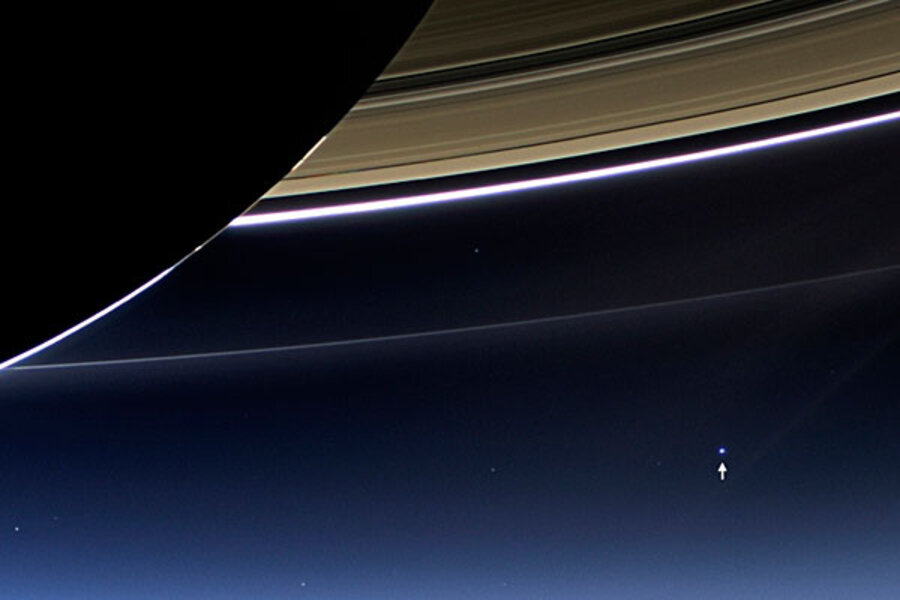Portrait of Earth from Saturn a reminder of just how amazing we are
Loading...
In about the time it once took to get Pocket Instamatic photos back from the drug store, NASA has processed and unveiled the latest portrait of Earth, taken by the Cassini orbiter currently touring Saturn and its moons.
Taken Friday and released Monday, the image is the second snapshot of the third rock from the sun Cassini has captured. The first appearance was serendipity, with Earth lurking in the background in a stunning backlit portrait of Saturn that Cassini took in 2006.
Taken from from a distance of 1.3 million miles, that image shows Saturn as a huge, darkened disk bordered by a thin ring of sunlit atmosphere and centered within its array of diaphanous, glowing rings.
This time, a similar attempt to image Saturn as it eclipsed the sun from Cassini's vantage point was designed from the get-go to capture Earth. Humans received a month's advanced notice to allow them (if they were in the mood and in the right hemisphere) to put on their "stepping out on a Friday night" clothes and get into the picture.
Last Friday's planetary photo op was three years in the making, according to Carolyn Porco, who leads Cassini's imaging team and cut her planetary-science teeth as a member of the imaging team for the Voyager missions to the outer solar system and beyond.
When the plan for the portrait went public a month ago, she noted in a statement that "my sincere wish is that people the world over stop what they are doing at the time the Earth picture is taken to revel in the sheer wonder of simply being alive on a pale blue dot of a planet" and appreciate the unique perspective such images provide on humanity's place in the solar system as well as its penchant for exploration.
NASA estimates that at least 20,000 people smiled for Cassini's imager, despite the anonymity they would continue to enjoy once the image was released. Earth is a tiny, if brilliant, speck in the distance, with the moon also in view.
"We may not be able to see individual continents or people in this portrait of Earth," acknowledged Linda Spilker, Cassini project scientist, in a statement released Monday. "But this pale blue dot is a succinct summary of who we were on July 19."
The image is the latest in a long line of images of Earth from space. Some were headlinemakers and magazine cover shots, such as the Earth rising above the moon's horizon taken by Apollo 8 astronauts in 1968 or Voyager 1's snapshot of Earth when the craft was 4 billion miles away. More common have been the relative closeups astronauts and cosmonauts have taken as still photos and later as movie and video sequences from low-Earth orbit.
Each in its own way allowed astronauts to share with the rest of the world a bit of the perspective that often led them to later express a deepened appreciation for the planet humans call home.
In a handwritten note after making history in 1961 as the first human to reach orbit, Soviet cosmonaut Yuri Gagarin put it this way: "Orbiting Earth in the spaceship, I saw how beautiful our planet is. People, let us preserve and increase this beauty, not destroy it."
Even if such sentiments might be written off as Cold War propaganda, spacefarers since have often said much the same thing.
Today, peering back at Earth during off hours is a popular pastime on the International Space Station. Back in March, during a Twitter exchange from orbit, NASA astronaut Thomas Marshburn noted that the station's cupola, which gives an expansive view of Earth, is a "very popular place on the station when we're not in the labs."
As for Cassini's latest portrait of planet Earth, the image "reminds us how tiny our home planet is in the vastness of space," Dr. Spilker said. But the image "also testifies to the ingenuity of the citizens of this tiny planet" in designing and operating spacecraft capable of visiting other planets and incorporating a tourist-like moment or two into the larger agenda of planetary exploration.







